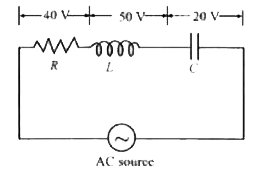In a L - C - R series AC circuit, the voltage across each of the component L, C and R is 50 V. The voltage across the L -R combination will be:
50 V
50√2 V
100 V
0 V
The correct Answer is:B
To solve the problem, we need to find the voltage across the L-R combination in a series L-C-R circuit where the voltage across each component (L, C, and R) is given as 50 V.
1. Understanding the Circuit:
In a series L-C-R circuit, the voltage across each component can be represented as:
- Voltage across the inductor (L): VL=50V
- Voltage across the capacitor (C): VC=50V
- Voltage across the resistor (R): VR=50V
2. Voltage Relationships:
In a series circuit, the total voltage across the circuit is the vector sum of the voltages across each component. The voltages across the inductor and capacitor are out of phase by 90 degrees, while the voltage across the resistor is in phase with the total current.
3. Using Phasor Representation:
Since VL and VC are 90 degrees out of phase, we can represent them as vectors:
- VL is along the positive y-axis.
- VR is along the x-axis.
4. Calculating the Voltage Across L-R Combination:
The voltage across the L-R combination can be calculated using the Pythagorean theorem because VL and VR are perpendicular to each other:
VLR=√V2L+V2R
Substituting the values:
VLR=√(50V)2+(50V)2
VLR=√2500+2500
VLR=√5000
VLR=50√2V
5. Final Calculation:
To express 50√2 in decimal form:
VLR≈50×1.414≈70.7V
Thus, the voltage across the L-R combination is approximately 70.7 V.
In a series L-C-R circuit, the voltage across each component can be represented as:
- Voltage across the inductor (L): VL=50V
- Voltage across the capacitor (C): VC=50V
- Voltage across the resistor (R): VR=50V
In a series circuit, the total voltage across the circuit is the vector sum of the voltages across each component. The voltages across the inductor and capacitor are out of phase by 90 degrees, while the voltage across the resistor is in phase with the total current.
Since VL and VC are 90 degrees out of phase, we can represent them as vectors:
- VL is along the positive y-axis.
- VR is along the x-axis.
The voltage across the L-R combination can be calculated using the Pythagorean theorem because VL and VR are perpendicular to each other:
VLR=√V2L+V2R
Substituting the values:
VLR=√(50V)2+(50V)2
VLR=√2500+2500
VLR=√5000
VLR=50√2V
To express 50√2 in decimal form:
VLR≈50×1.414≈70.7V
Topper's Solved these Questions
Similar Questions
Knowledge Check
In an LCR series circuit, the voltage across each of the components L,C and R is 20 V. The voltage across the L-C combination will be
A20 VB40 VCzeroD20√2VIn an LCR series a.c. circuit, the voltage across each of the components L, C and R is 50 V. The voltage across the LC combination will be
A50 VB50√2 VC100 VD0 VIn an LCR series ac circuit , the voltage across each of the components , L,C and R is 50 V . The voltage across the LC combination will be :
A50 VB50√2 VC100 VD0 V (zero)
In an LCR series a.c. circuit, the voltage across each of the components L,C, and R is 60 V. What is the voltage across the LC combination ?
View SolutionIn an L-C-R series, AC circuit at resonance
View SolutionIn an L-C-R circuit the AC voltage across R, L and C comes out as 10 V , 10 V and 20 V respectively . The voltage across the enter combination will be
View SolutionIn an LCR circuit, the voltages across the components are VL,VC and VR respectively. The voltage of source will be -
View SolutionIn series LCR circuit, the voltages across R, L and C shown in figure. The voltage of applied source is

View Solution
